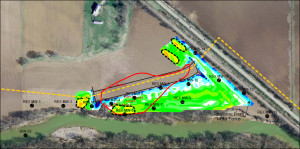Challenge
The construction of the 42-inch diameter natural gas pipeline across Indiana involved the crossing of multiple areas of pre-historic and historic cultural significance. In one such area, where there was concern regarding the impact of the construction on drinking water quality, groundwater monitoring wells needed to be installed. As part of that effort, the proposed wells needed to be placed in areas across the site not known to contain any features of potential cultural significance. Mundell was contracted by REX to evaluate the site so that placement of the wells could avoid disturbance of any such archaeologically significant areas.
Technical Approach
Mundell performed time domain electromagnetic terrain conductivity mapping using an EM-38 conductivity meter manufactured by Geonics, Ltd., and magnetic field mapping using the high resolution G-858 Cesium magnetometer manufactured by Geometrics Ltd. The EM-38 and G-858 data were collected by securing the instruments to a rigid plastic sledge and towing them behind an all terrain vehicle. The data were collected along lines spaced approximately 1 to 1.5 meters apart with an in-line data point spacing of 0.3 meters. Positioning data were provided by a Trimble Ag114 global positioning system (GPS) receiver with real-time satellite based differential correction. Once the data were gathered, they were transferred to a computer and imported into Surfer Version 8.0 for contouring and plotting as color-filled contour maps of terrain conductivity and anomalous magnetic field strength (shown in the inset figure above).
Results
This approach provided not only left potential historic site features in a pristine condition, but it also gave the pipeline company peace of mind, knowing that they had exercised their due diligence.




